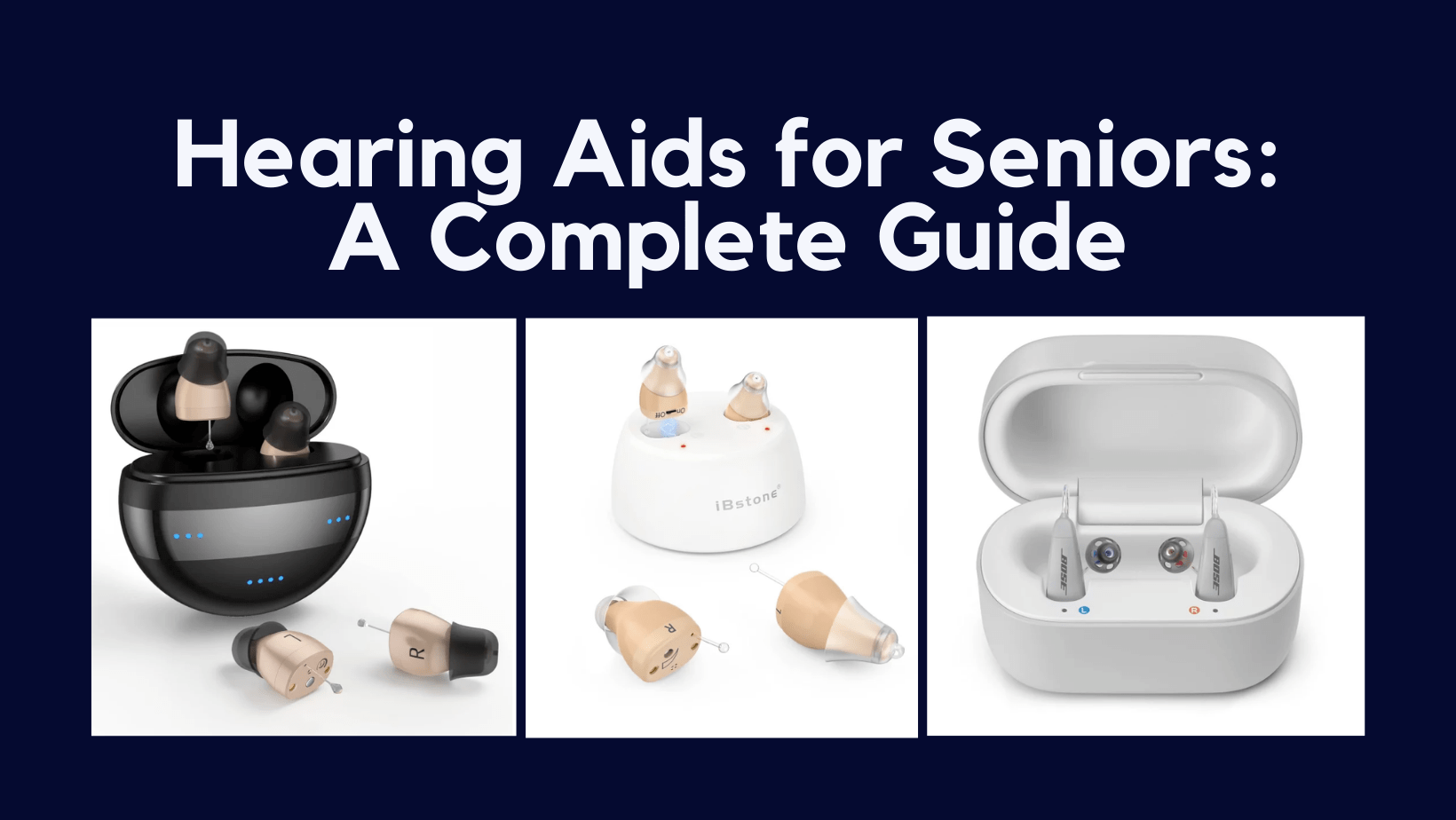Best Hearing Aids for Seniors: A Complete Guide for 2024
Introduction to Hearing Aids for Seniors
Hearing loss is a common challenge faced by many seniors. It’s a gradual process, often unnoticed at first, but over time it can significantly impact daily communication and quality of life. As we age, the delicate structures inside our ears may deteriorate, leading to various degrees of hearing impairment. This natural age-related hearing loss, known as presbycusis, along with factors like prolonged exposure to loud noises, certain medical conditions, and medications, contributes to the prevalence of hearing challenges in the senior population.
The importance of choosing the right Hearing Aids for Seniors cannot be overstated. A well-selected hearing aid not only improves hearing but also enriches life’s experiences, from the joy of conversations with loved ones to the simple pleasures like the sound of birds chirping. With the right device, seniors can regain a significant portion of their auditory abilities, leading to improved social interactions, better mental health, and a higher overall quality of life.
In this article, we will explore the various types of hearing aids available for seniors. Each type offers unique features and benefits, tailored to different degrees of hearing loss and lifestyle needs. We’ll delve into these types of Hearing Aids for Seniors: Behind-The-Ear (BTE), In-The-Ear (ITE), In-The-Canal (ITC), Completely-In-Canal (CIC), Receiver-In-Canal (RIC), and Invisible hearing aids. By understanding the specifics of each, you can make an informed decision about which hearing aid will best suit your individual needs, preferences, and lifestyle. Let’s embark on this journey to better hearing together.
Understanding Hearing Loss in Seniors – Hearing Aids for Seniors
The Basics of Hearing Loss
Explanation of How Hearing Works
Hearing is a complex process that involves both the ear and the brain. Sound waves enter the ear canal, causing the eardrum to vibrate. These vibrations are then transmitted through the three small bones in the middle ear, which amplify and convey them to the cochlea in the inner ear. The cochlea, filled with fluid and lined with thousands of tiny hair cells, converts these vibrations into electrical signals. These signals are sent via the auditory nerve to the brain, where they are interpreted as the sounds we hear.
Common Causes of Hearing Loss in Seniors
In seniors, hearing loss typically occurs for several reasons:
- Age-Related Changes: Known as presbycusis, this gradual loss of hearing is due to changes in the inner ear as we age. It often affects both ears and mainly impacts the ability to hear higher frequencies.
- Noise Exposure: Long-term exposure to loud noises can damage the delicate hair cells in the cochlea, leading to noise-induced hearing loss.
- Medical Conditions: Conditions like diabetes, hypertension, and heart disease can affect hearing. Otosclerosis, which alters the bones in the middle ear, and Meniere’s disease, which affects the inner ear, can also lead to hearing loss.
- Medications: Certain medications, known as ototoxic drugs, can damage hearing. These include some types of antibiotics, chemotherapy drugs, and large quantities of aspirin.
Impact of Hearing Loss
Emotional and Social Effects
Hearing loss can have profound emotional and social effects on seniors:
- Social Withdrawal: Difficulty in following conversations can lead to avoidance of social situations, leading to feelings of isolation.
- Depression and Anxiety: The frustration and loneliness stemming from hearing loss can contribute to depression and anxiety.
- Cognitive Decline: There is a growing body of research suggesting that untreated hearing loss may be linked to cognitive decline, including an increased risk of dementia.
Importance of Addressing Hearing Loss
Addressing hearing loss is crucial for maintaining a high quality of life:
- Improved Communication: Effective hearing aids can significantly improve communication, enabling better interaction with family and friends.
- Enhanced Safety: Good hearing is essential for detecting hazards in the environment, such as oncoming traffic or emergency alarms.
- Mental Health Benefits: Addressing hearing loss can alleviate feelings of social isolation and depression, leading to a more active, engaging, and happy life.
By understanding the basics of hearing loss and its impact, seniors and their loved ones can take proactive steps to address this common yet manageable condition.
Types of Hearing Aids – Hearing Aids for Seniors
Behind-The-Ear (BTE) Hearing Aids
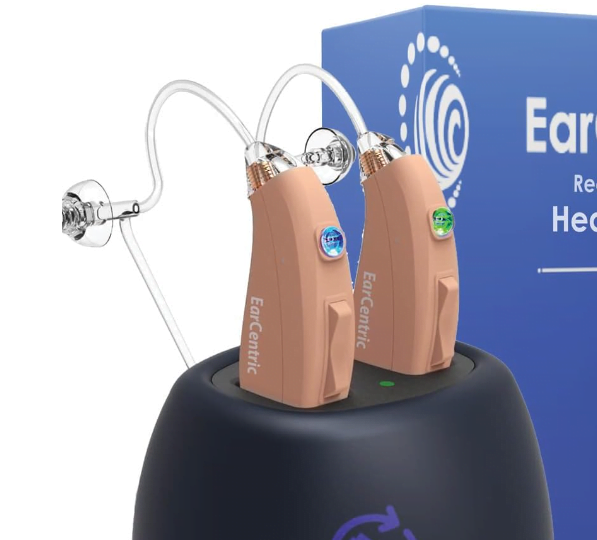
Description and How They Work
Behind-The-Ear (BTE) Hearing Aids for Seniors are among the most common types. They consist of a small plastic case that sits behind the ear, connected to an earmold or earpiece by a clear tube. The case contains the main components of the hearing aid: the microphone, amplifier, and speaker. Sound is collected by the microphone, amplified, and then sent through the tube into the ear.
Pros and Cons
Pros:
- Suitable for most types of hearing loss.
- Larger size allows for bigger batteries and longer battery life.
- Easier to handle and maintain, especially for seniors with dexterity issues.
Cons:
- More visible than smaller, in-the-ear models.
- Can pick up more wind noise.
In-The-Ear (ITE) Hearing Aids
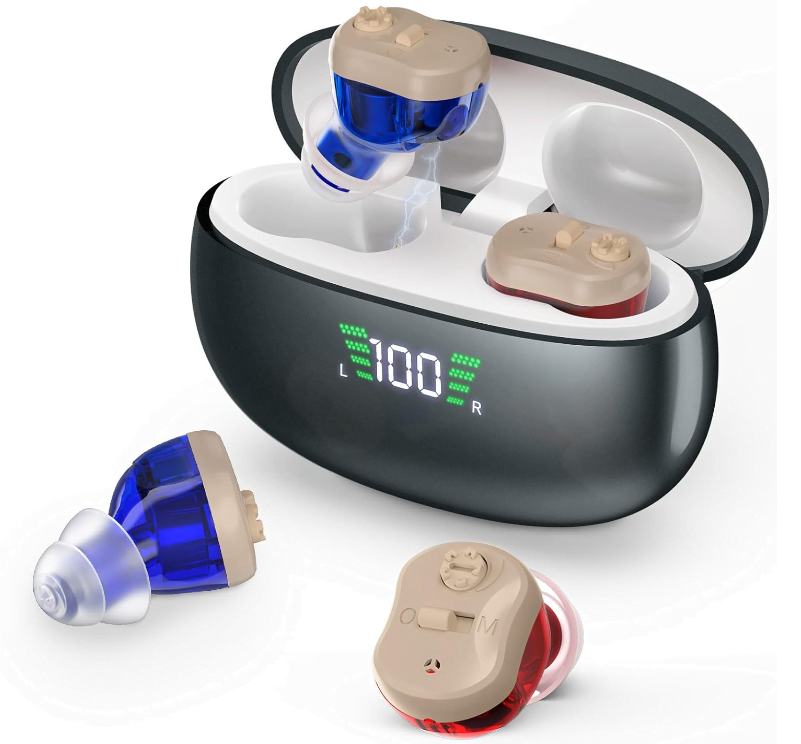
Description and How They Work
In-The-Ear (ITE) Hearing Aids for Seniors are custom-made to fit entirely within the outer ear. They are larger than in-the-canal models but smaller than BTE aids. All parts of the hearing aid are housed in a shell that sits in the outer part of the ear.
Pros and Cons
Pros:
- Less visible than BTE aids.
- Easy to insert and remove, beneficial for seniors with dexterity issues.
- Larger than ITC and CIC aids, making them easier to handle.
Cons:
- Can be more prone to earwax clogging than BTE models.
- Smaller than BTE aids, which means smaller batteries and shorter battery life.
In-The-Canal (ITC) and Completely-In-Canal (CIC) Hearing Aids
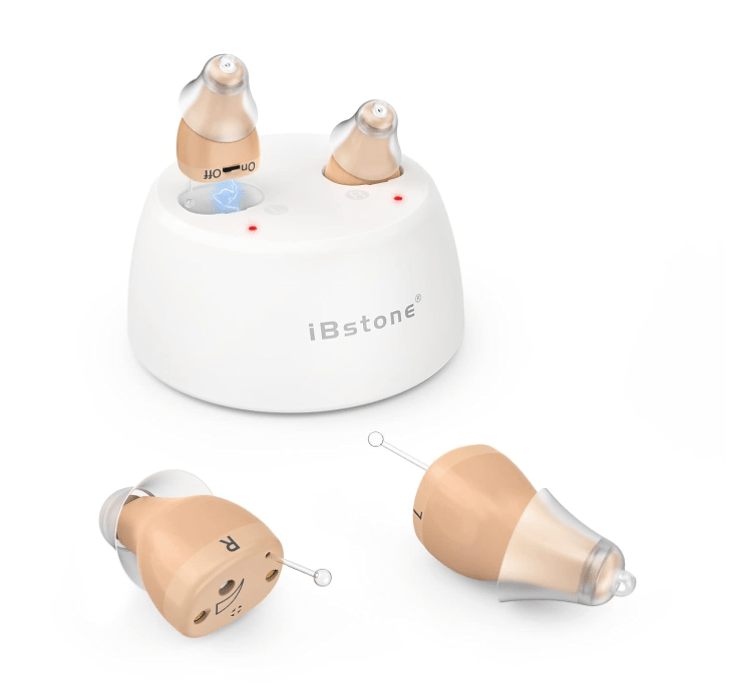
Description and How They Work
In-The-Canal (ITC) and Completely-In-Canal (CIC) Hearing Aids for Seniors are smaller than ITE aids and are designed to fit partly or completely in the ear canal. ITC aids are custom molded and fit partly in the ear canal, while CIC aids are smaller and fit almost completely in the canal, making them nearly invisible.
Pros and Cons
Pros:
- Very discreet due to their small size.
- Less likely to pick up wind noise due to their position in the ear canal.
Cons:
- Small size means they can be difficult to handle, especially for seniors with limited dexterity.
- More susceptible to earwax clogging.
- Smaller batteries mean shorter battery life.
Receiver-In-Canal (RIC) Hearing Aids
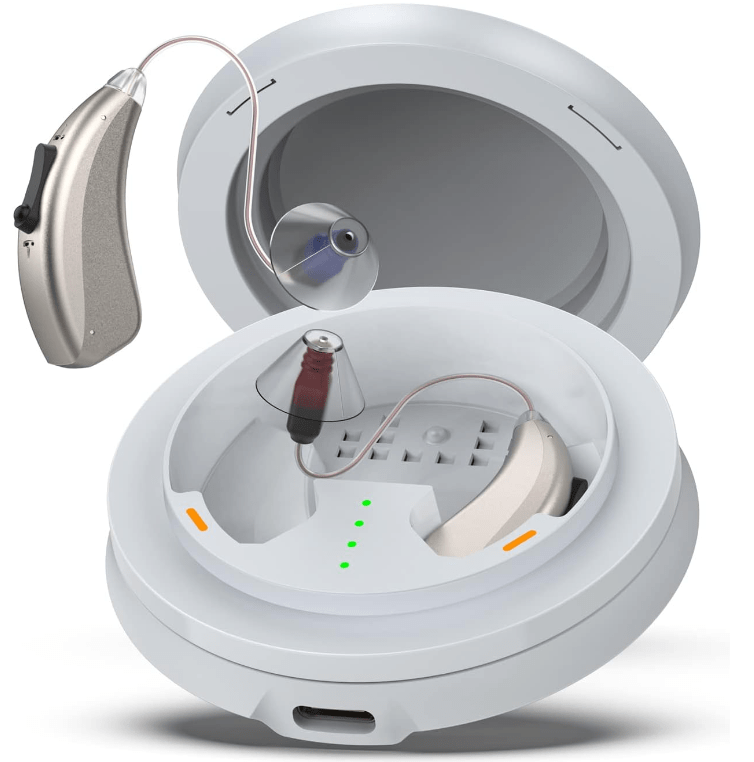
Description and How They Work
Receiver-In-Canal (RIC) Hearing Aids for Seniorsare similar to BTE models but with a key difference: the speaker or receiver is inside the ear canal. A thin wire replaces the acoustic tube of the BTE aid, connecting the case to the receiver.
Pros and Cons
Pros:
- Less visible than traditional BTE aids.
- Can provide a more natural sound quality.
- Suitable for a wide range of hearing loss levels.
Cons:
- May be more prone to moisture and earwax damage than BTE models.
- Slightly more visible than ITC and CIC models.
Invisible Hearing Aids
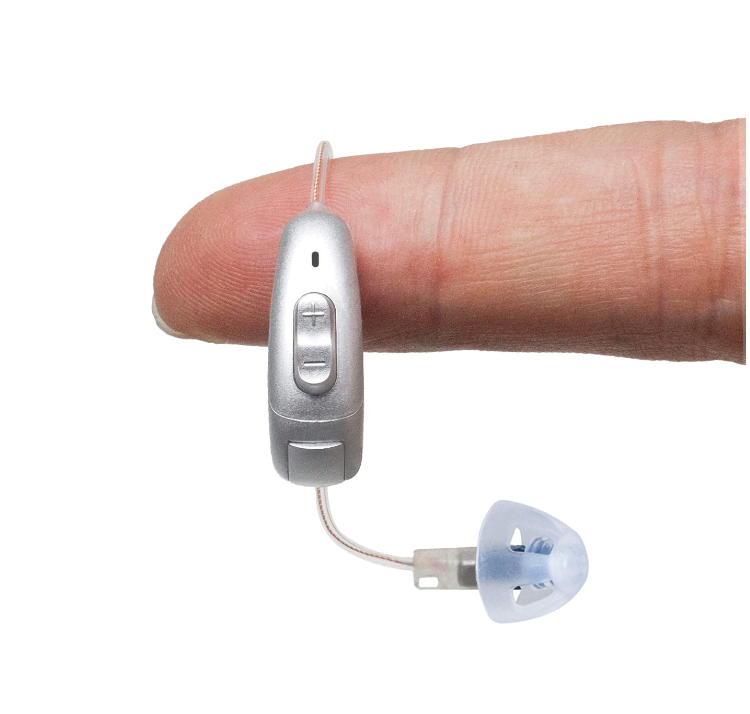
Description and How They Work
Invisible Hearing Aids for Seniors are the smallest available. They are placed deeply in the ear canal, making them virtually invisible. Each device is custom-fitted to sit completely in the ear canal.
Pros and Cons
Pros:
- Virtually invisible, offering an excellent cosmetic option.
- Reduces feelings of ear fullness, offering comfort and a natural sound quality.
Cons:
- Not suitable for all types of hearing loss, particularly severe loss.
- Small size can make them difficult to handle and maintain.
- Limited space for batteries and additional features.
Each type of hearing aid offers unique benefits and potential drawbacks, making it essential for seniors to consider their specific hearing needs, lifestyle, and personal preferences when choosing a hearing aid.
Choosing the Right Hearing Aid – Hearing Aids for Seniors
Factors to Consider in Hearing Aids for Seniors
When it comes to selecting the right hearing aid, several factors should be taken into account to ensure that the chosen device aligns well with the user’s needs and lifestyle.
Lifestyle and Activity Level
- Active Lifestyles: For seniors who are physically active or often find themselves in different listening environments, advanced hearing aids with features like noise reduction and directional microphones may be beneficial.
- Quiet Lifestyles: Those who spend most of their time in quieter settings may prefer basic hearing aids that amplify sound without many additional features.
Degree of Hearing Loss
- Mild to Moderate Loss: Seniors with mild to moderate hearing loss might find In-The-Canal (ITC) or In-The-Ear (ITE) hearing aids sufficient.
- Severe Loss: For those with severe hearing loss, Behind-The-Ear (BTE) or Receiver-In-Canal (RIC) models, known for their power and effectiveness, may be more appropriate.
Manual Dexterity and Ease of Use
- Handling and Maintenance: Seniors with limited manual dexterity may find larger models like BTE or ITE hearing aids easier to handle and maintain.
- Control Features: Devices with easy-to-use controls, such as larger buttons or touchpads, can be more user-friendly for those who might struggle with smaller, more intricate parts.
Professional Consultation and Hearing Tests
Importance of Professional Advice
- Personalized Recommendations: Audiologists can provide personalized recommendations based on a comprehensive assessment of an individual’s hearing loss, lifestyle, and physical capabilities.
- Fitting and Adjustments: They also assist in the fitting of the hearing aids and make necessary adjustments for optimal performance.
Understanding Hearing Tests and Their Outcomes
- Hearing Evaluation: A standard hearing test, or audiogram, evaluates the ability to hear various frequencies and volumes. This test helps in determining the degree and type of hearing loss.
- Interpreting Results: The audiologist interprets these results to recommend the most suitable type of hearing aid. They can also explain how different hearing aids work and suggest models that align with the user’s specific needs.
Choosing the right hearing aid is a critical decision that can significantly improve the quality of life for seniors experiencing hearing loss. Considering factors like lifestyle, degree of hearing loss, and ease of use, along with seeking professional advice and understanding hearing test outcomes, can help in making an informed choice.
New Technology and Advancements in Hearing Aids for Seniors
Digital Technology in Hearing Aids for Seniors
The evolution of digital technology has significantly transformed hearing aids, making them more versatile and effective in various listening environments.
Explanation of Digital Features
- Noise Reduction: This feature helps in diminishing background noise, making it easier for the user to focus on speech. It is particularly beneficial in noisy environments like restaurants or social gatherings.
- Directional Microphones: These microphones enhance sound from a specific direction, typically where the user is facing. This feature improves the ability to hear in environments with background noise by focusing on the sound source in front of the user.
- Feedback Suppression: Modern hearing aids include feedback suppression to reduce or eliminate whistling sounds that can occur, especially in high-gain settings.
- Multiple Listening Programs: Many digital hearing aids come with the ability to switch between pre-set programs, optimized for different listening environments (e.g., quiet settings, noisy rooms, or outdoors).
Connectivity and Smart Features of Hearing Aids for Seniors
Advancements in connectivity and smart technology have also been integrated into modern hearing aids, enhancing the user experience.
Bluetooth Connectivity
- Wireless Connectivity: Bluetooth-enabled hearing aids can wirelessly connect to various devices, including smartphones, tablets, TVs, and music players, allowing direct streaming of audio.
- Hands-Free Calls: Users can answer phone calls directly through their hearing aids, making communication more convenient and clearer.
Smartphone Compatibility
- Personalized Control: Many hearing aids can be controlled via smartphone apps, allowing users to adjust settings like volume and programs directly from their phones.
- Remote Fine-Tuning: Some models offer remote fine-tuning by audiologists. This feature enables the audiologist to adjust the hearing aid settings remotely, based on the user’s feedback, without the need for an in-person visit.
- Geo-tagging: Advanced hearing aids can remember preferred settings for specific locations (like home, work, or a favorite restaurant) and automatically switch to these settings when the user enters these locations.
These technological advancements not only enhance the functionality of hearing aids but also significantly improve the overall user experience, offering seniors an opportunity to enjoy clearer hearing seamlessly integrated with the digital aspects of their lives.
Maintenance and Care of Hearing Aids for Seniors
Daily Maintenance Tips for Hearing Aids for Seniors
Proper maintenance is crucial for the longevity and performance of hearing aids. Regular care ensures they function optimally and reduces the likelihood of repairs.
Cleaning and Care
- Daily Cleaning: Wipe the hearing aid each day with a soft, dry cloth. Avoid water and cleaning solvents.
- Earwax Removal: Use a soft brush or a specialized tool provided by the audiologist to gently remove earwax from the hearing aid’s openings.
- Moisture Control: Keep hearing aids dry. Use a hearing aid dehumidifier overnight if necessary.
Battery Management
- Regular Replacement: Change batteries regularly or charge them as per the manufacturer’s instructions.
- Battery Storage: Store spare batteries in a cool, dry place. Avoid extreme temperatures.
- Handling Batteries: Handle batteries with clean, dry hands to prevent corrosion.
Maintenance and Repairs for Hearing Aids for Seniors
When to Seek Professional Help
- Annual Check-ups: Have hearing aids professionally checked at least once a year.
- Performance Issues: If there are changes in hearing aid performance, such as distorted sound or reduced amplification.
- Physical Damage: Seek professional assistance for any visible damage or if the hearing aid is not functioning even after battery replacement.
Conclusion to Hearing Aids for Seniors
Selecting the right hearing aid is a pivotal step towards better hearing and improved quality of life for seniors. It’s not just about amplifying sound; it’s about enhancing the ability to connect with the world and loved ones. The advancements in technology and the variety of options available today make it possible to find a hearing aid that fits almost any need and lifestyle.
We encourage seniors experiencing hearing loss to seek professional advice. Audiologists can help you navigate through the options and find a hearing aid that suits your specific hearing needs, lifestyle preferences, and budget. Embracing the world of improved hearing can open up a new chapter of engagement and enjoyment in your daily life.
Remember, hearing aids are more than just devices; they are a gateway to a clearer, fuller, and more vibrant world of sound. With the right choice, maintenance, and care, they can significantly enhance your hearing experience and overall quality of life.
Resources:
The National Institute on Deafness and Other Communication Disorders (NIDCD)
The Hearing Loss Association of America (HLAA)
The American Academy of Audiology (AAA)

